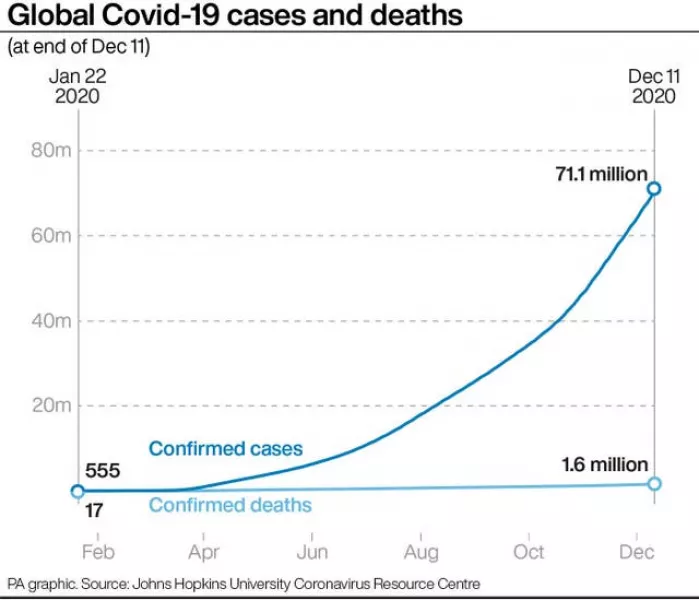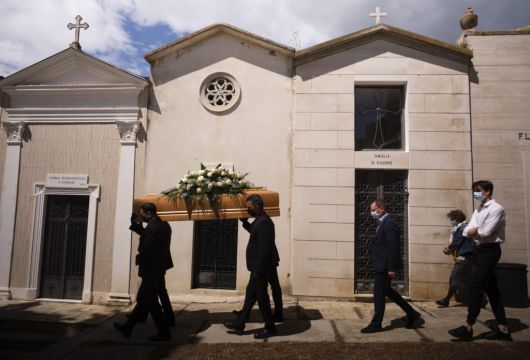Italy could soon reclaim a record no nation wants – the most coronavirus deaths in Europe – amid claims the health system has again failed to protect the elderly and the government delayed imposing new restrictions.
Italy was the first country in the West to be hit by Covid-19 early in 2020, but after suffering a huge wave of deaths in the spring it finally brought infections under control.
It had the benefit of time and experience heading into the autumn resurgence because it trailed Spain, France and Germany in recording big new clusters of infections.
Yet the virus spread fast and wide, and Italy has added 28,000 further deaths since September 1.
This week, it reported a pandemic-high record of 993 deaths in one day.
Italy added another 761 victims on Friday, bringing its official total to 63,387.
That is just shy of the 63,603 deaths which have taken place in Britain, according to Johns Hopkins University.
Both numbers are believed to greatly underestimate the real toll, due to missed infections, limited testing and different counting criteria.
Guido Rasi, former executive director of the European Pharmaceutical Agency, said: “Obviously there needs to be some reflection. This number of nearly 1,000 dead in 24 hours is much higher than the European average.”
Italy could soon overtake Britain despite having six million fewer citizens, and would then trail only the much larger nations of the US, Brazil, India and Mexico.
According to the Hopkins tally, Italy also has the most deaths per 100,000 population among the most affected countries.
Public health officials argue Italy has the world’s second-oldest population after Japan, and the elderly are the most vulnerable to the virus.
The average age of Italian victims has hovered around 80.
In addition, 65% of Italy’s Covid-19 dead had three or more other health problems before they tested positive, such as hypertension or diabetes, according to Italy’s Superior Institute of Health.
But Germany has a similarly old demographic and yet its death toll is one-third of Italy’s despite its larger population of 83 million.
Germany recorded its highest daily number of coronavirus victims on Friday – 598 – but has seen only 21,000 fatalities overall.
Analysts point to Germany’s long-term higher per-capita spending on health, which has resulted in greater ICU capacity, better testing and tracing capabilities and higher ratios of doctors and nurses to the population.

But Germany also imposed an earlier, lighter lockdown this autumn and is now poised to tighten it.
Matteo Villa, research fellow at the Institute for International Political Studies in Milan, said: “If you can act sooner, even a bit lighter in the measures, they work better than acting harshly a bit later or too late.”
Italy, he said, waited too long after infections started ticking up in September and October to impose restrictions and did not reinforce its medical system sufficiently during the summer lull.
“If you look at France and the UK, you can see Italy did fare much worse,” he said. “And if you look at a comparable population with similar demographics, which is Germany, Italy did a lot worse.”
With another wave of infections feared to be just around the corner with Christmas visits and the winter flu season, many are wondering how many more will die.
Doctors have blamed systemic problems with Italy’s health system, especially in hardest-hit Lombardy, for failing to respond adequately.
Nearly 80,000 Italian healthcare workers have been infected and 255 doctors have died.
Dr Filippo Anelli, head of the country’s doctors’ association, said: “We asked for a lockdown at the start of November because the situation inside hospitals was already difficult.

“We saw that it worked in the spring and allowed us to get out from under Covid. If this had been done, probably today the numbers would be coming down.”
But the Italian government resisted reimposing a nationwide lockdown, knowing the devastating impact on an economy that was just starting to come back to life after the spring shutdown.
Instead, on November 3 the government divided the country into three risk zones with varying restrictions.
But by then infections had been doubling each week for nearly a month and hospitals were already overwhelmed in Milan and Naples.
Italy also went into the pandemic poorly prepared, with fewer ICU beds than the average of developed countries.
In recent weeks, investigative news reports have noted Italy had not updated its influenza pandemic preparedness plan since 2006 – which could help explain its critical shortage of protective equipment early on and its chaotic initial response to the pandemic.
A World Health Organisation report, which was posted but then taken down from the WHO website, noted Italy’s 2006 plan was merely “reconfirmed in 2017” without being updated. The report said the plan was “more theoretical than practical” and when Covid-19 hit, chaos ensued.
“Unprepared for such a flood of severely ill patients, the initial reaction of the hospitals was improvised, chaotic and creative,” said the report.







